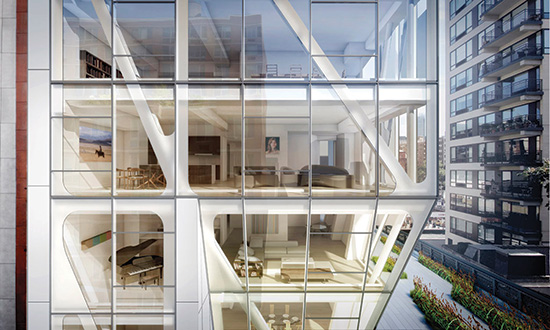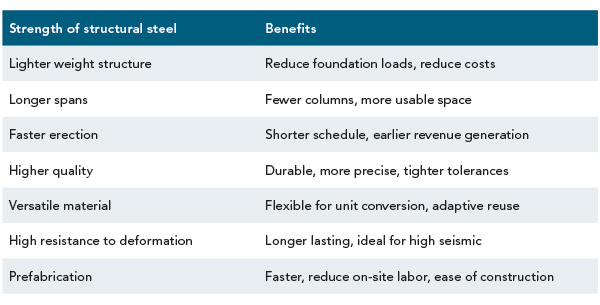Achieving Higher Quality in High-Density Residential: the Strengths of Structural Steel
Learning Objectives:
- Compare the advantages of structural steel framing to other building materials
- Explore system concepts that allow the architect greater flexibility in programming and design of apartments and condominiums
- Determine economical methods of design
- Analyze faster methods of construction in using structural steel framing
Credits:
Forward-thinking architects are developing designs that maximize usable area, provide versatility, and create high-quality long-lasting buildings using structural steel systems. Structural steel framing has recognized benefits in apartment and condominium design, effectively addressing the challenges of limited program space, speed of construction and future adaptability to changing needs. It is an ideal solution for mid-rise and high-rise structures where economy can be gained through repetition of the structural members. The most successful projects are a result of a collaborative team effort. As the building structure is always on the critical path, the benefit of designing with structural steel is a reduced overall construction schedule with effective planning.
The Strengths of Structural Steel
Structural steel has historically found great efficiency in the design of office buildings, warehouses, and most other non-residential building types. Apartment and condominium projects constructed using conventional or innovative steel systems are now being recognized for high performance and quality. These buildings take full advantage of the following benefits of using structural steel:
Highly sustainable. Steel is the most recycled material in the world.1 The recycled content of structural steel beams and columns produced in the United States averages 90 percent. A striking 98 percent of structural steel is recovered at end-of-life for reuse or recycling. The structural steel industry continues to reduce its low greenhouse gas emissions and energy intensity. Results of these efforts are evident in recent findings on greenhouse gases, which show the iron and steel industry reduced carbon emissions by 37 percent and energy intensity by 32 percent between 1990 and 2013 on a per ton basis.2

Image courtesy of Neil Denari Architects
More usable space. Longer spans and smaller columns allow for more usable floor area and fewer structural intrusions in open spaces. Two key selling factors in apartments and condominiums are open views and maximum free space. For example, in a 10-story residential building with 30-foot structural bays, 13 inch by 13 inch steel columns would translate to approximately 18 inch by 18 inch concrete columns for the equivalent loads. Steel columns have a reduced structural footprint compared to concrete, allowing for the greatest flexibility in furniture layout and more unobstructed views.
Fast erection and assembly. Structural steel is fabricated and erected in nearly all weather conditions with no formwork requirements, which significantly reduces the time for construction. An excellent choice for fast-track construction, structural steel framing meets owner needs to bring apartments and condominiums to market on time. A shorter schedule allows owners to reduce financing costs and generate revenue earlier.
Durable and long-lasting. The combination of a high-strength, low-weight material and resistance to rot and insects are prime elements contributing to the durability of structural steel. Apartment and condominium buildings utilizing structural steel framing inherently have a long life span due to the long-term performance of the material. Structural steel can be recaptured from demolition sites and reused multiple times prior to being recycled. The framing components may be disassembled and salvaged, a cleaner process than the demolition of concrete buildings which leads to more dust and pollution in the air.
Versatile. Structural steel framing handles changes to load and occupancy requirements with ease, extending the functional life of buildings. Additional reinforcement is simple and straightforward with steel and can be designed to support changes of use, increased loads, additional floors, and longer spans. An ideal system for unit conversion or adaptive reuse, the versatility of structural steel highlights the benefits for apartment and condominium designs.
Aesthetic options. Structural steel offers a wide range of shapes and sizes that allow a multitude of options for building cladding and expression. Recognized for its slenderness and grace, steel can be shaped into tight curves and broad arches, and utilized for long cantilevers. Steel may be exposed architecturally and should be protected from fire and corrosion where required. Methods of fire protection range from intumescent coating to cementitious spray-proofing, while design for corrosion includes options such as galvanizing or painting depending on the exposed condition.
Strong seismic performance. A ductile material such as steel is excellent for high-density residential buildings in seismic zones, where safety is critical for large numbers of occupants. Structural steel systems offer the highest level of safety in seismic design. Seismic design is required in approximately half of the geographic area of the United States. The lightweight nature of steel reduces the seismic base shear by about one-third compared to an all-concrete structure, which results in a significant reduction in foundation loads.










